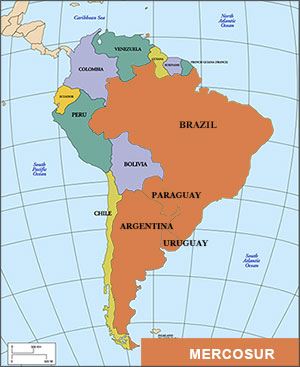Pharmacoeconomic Guidelines: MERCOSUR (Argentina, Brazil, Paraguay, Uruguay)
Country/Region: MERCOSUR (Argentina, Brazil, Paraguay, Uruguay)

PE Guidelines
MERCOSUR - GUÍA PARA ESTUDIOS DE EVALUACIÓN ECONÓMICA DE TECNOLOGÍAS SANITARIAS/ GUIDELINE FOR ECONOMIC EVALUATION OF HEALTH TECHNOLOGIES
PE Guidelines Source:
Common Market of the Southern Cone (MERCOSUR): Argentina, Brazil, Paraguay, Uruguay.
http://www.mercosur.int
http://www.mercosur.int
Information current as of Monday, August 8, 2022
Key Features
| Key Features | |
|---|---|
| Type of Guidelines | PE Guidelines |
| Title and year of the document | GUIDELINES FOR ECONOMIC EVALUATION OF HEALTH TECHNOLOGIES (2015) |
| Affiliation of authors | |
| Purpose of the document | To establish the procedures and methods to be used by analysts and researchers to produce, conduct, describe, report, and assess economic evaluations of health technologies in the member states. |
| Standard reporting format included | Yes |
| Disclosure | Yes |
| Target audience of funding/ author's interests | Researchers who conduct EE and decision makers |
| Perspective | Must be defined and reported. For decisions related to public policies, the preferred perspective should be the one of the public health system. Society perspective should include, all the direct costs of the production of the service/procedure, the times lost by the patients and their relatives, and the costs related to the loss of productivity and premature death. |
| Indication | Not specified. |
| Target population | Must be clearly specified which population groups or subgroups will benefit from the inclusion of the new technology (target population). The population included in the EE should be specified and fully described (sociodemographic characteristics according to the nature, progression or severity of the disease and the existence of comorbidities and/or other aggravating factors). If data on effectiveness was obtained from multiple sources of different populations, the report must provide a detailed description of the method used to arrive at the definition of the target population and to estimate of the effectiveness. |
| Subgroup analysis | Yes |
| Choice of comparator | Comparators must be relevant and cover all the usual alternatives to all proposed uses of the assessed technology. |
| Time horizon | Must be mention and justified. For chronic diseases and conditions with significant differences in survival, the time horizon should be life expectancy. If a long term analysis is impossible, a shorter analysis should be justified and made using feasible data. |
| Assumptions required | Not specified. |
| Preferred analytical technique | There is no preference, the analytical technique should be justified and adequate to answer the research question. |
| Costs to be included | Should be appropriate for the chosen perspective (direct health care costs, indirect costs, patient and family costs, productivity loss). |
| Source of costs | Should be described and justified. |
| Modeling | Modeling methodology should be described and justified, it must be possible to incorporate all relevant parameters and disease stages. Model must be flexible and adaptable. |
| Systematic review of evidences | Not specified. |
| Preference for effectiveness over efficacy | Yes |
| Preferred outcome measure | Effectiveness |
| Preferred method to derive utility | Should be described and justified. |
| Equity issues stated | Yes. A detailed discussion should be included on the possible effects of the distribution of the health interventions or programs considered in different population groups, and other aspects related to equity in the allocation of resources. |
| Discounting costs | Yes |
| Discounting outcomes | Yes |
| Sensitivity analysis-parameters and range | Should be described and justified. |
| Sensitivity analysis-methods | Should be described and justified. |
| Presenting results | Report has to be clear, transparent and detailed. The guideline describe the recommended format. |
| Incremental analysis | Yes |
| Total costs vs effectiveness (cost/effectiveness ratio) | Yes |
| Portability of results (Generalizability) | Not specified. |
| Financial impact analysis | BIA must be provided |
| Mandatory or recommended or voluntary | Recommended |
Acknowledgement: